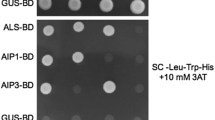Abstract
Brassinosteroid (BR)-6-oxidases mediate the bridge reactions that connect the late and early C-6 oxidation pathways by converting 6-deoxoBR to 6-oxoBRs. Two similar genes ofArabidopsis, CYP85A1 (At5g38970) andCYP85A2 (At3g30180), are proposed to encode BR-6-oxidases based on findings that heterologously expressed genes mediate BR-6-oxidation reactions in yeast. However, genetic evidence that both genes are critically involved in the BR-6-oxidation step inArabidopsis has been limited. Here, we show that a double mutant for the two genes displays dwarfism similar to that of typical BR biosynthesis-deficient mutants, suggesting that they are the major BR-6-oxidases inArabidopsis. Examination of endogenous BR levels and metabolism monitoring tests using this double mutant revealed a great reduction in the levels of 6-oxoBRs, e.g., TY and CS, due to a lack in the conversion reactions from 6-deoxoCS to CS, and from 6-deoxoTY to TY. Surprisingly, the double mutant accumulated a significant amount of 6-oxocampestanol, suggesting that the upstream C-6 oxidation of campestanol to 6-oxocampestanol is not catalyzed by the two BR-6-oxidases inArabidopsis, rather, by another enzyme yet to be discovered.
Similar content being viewed by others
Literature Cited
Alonso JM, Stepanova AN, Leisse TJ, Kim CJ, Chen H, Shinn P, Stevenson DK, Zimmerman J, Barajas P, Cheuk R, Gadrinab C, Heller C, Jeske A, Koesema E, Meyers CC, Parker H, Prednis L, Ansari Y, Choy N, Deen H, Geralt M, Hazari N, Horn E, Karnes M, Mulholland C, Ndubaku R, Schmidt I, Guzman P, Aguilar-Henonin L, Schmid M, Weigel D, Carter DE, Marchand T, Ris-seeuw E, Brogden D, Zeko A, Crosby WL, Berry CC, Ecker JR (2003) Genome-wide insertional mutagenesis ofArabidopsis thaliana. Science 301: 653–657
Asami T, Mizutani M, Fujioka S, Coda H, Min YK, Shimada Y, Nakano T, Takatsuto S, Matsuyama T, Nagata N, Sakata K, Yoshida S (2001) Selective interaction of triaz-ole derivatives with DWF4, a cytochrome P450 monooxygenase of the brassinosteroid biosynthetic pathway, correlates with brassinosteroid deficiency in planta. J Biol Chem 276: 25687–25691
Bishop GJ, Harrison K, Jones JD (1996) The tomato Dwarf gene isolated by heterologous transposon tagging encodes the first member of a new cytochrome P450 family. Plant Cell 8: 959–969
Bishop GJ, Nomura T, Yokota T, Harrison K, Noguchi T, Fujioka S, Takatsuto S, Jones JD, Kamiya Y (1999) The tomato DWARF enzyme catalyses C-6 oxidation in brassinosteroid biosynthesis. Proc Natl Acad Sci USA 96: 1761–1766
Choe S (2005) Brassinosteroid biosynthesis and metabolism.In Davies PJ, ed, Plant Hormones: Biosynthesis, Signal Transduction, and Action. Springer, Syracus, pp 156–178
Choe S, Fujioka S, Noguchi T, Takatsuto S, Yoshida S, Feld-mann KA (2001) Overexpression ofDWARF4 in the brassinosteroid biosynthetic pathway results in increased vegetative growth and seed yield inArabidopsis. Plant J 26: 573–582
Choe S, Noguchi T, Fujioka S, Takatsuto S, Tissier C, Gregory B, Ross A, Tanaka A, Yoshida S, Tax F, Feldmann KA (1999) The Arabidopsisdwf7/ste1 mutant is defective in the delta 7 sterol C-5 desaturation step leading to brassinosteroid biosynthesis. Plant Cell 11: 207–221
Fujioka S, Noguchi T, Watanabe T, Takatsuto S, Yoshida S (2000) Biosynthesis of brassinosteroids in cultured cells ofCatharanthus roseus. Phytochem 53: 549–553
Hong Z, Ueguchi-Tanaka M, Shimizu-Sato S, Inukai Y, Fujioka S, Shimada Y, Takatsuto S, Agetsuma M, Yoshida S, Watanabe Y, Uozu S, Kitano H, Ashikari M, Matsuoka M (2002) Loss-of-function of a rice brassinosteroid biosynthetic enzyme, C-6 oxidase, prevents the organized arrangement and polar elongation of cells in the leaves and stem. Plant J 32: 495–508
Hong Z, Ueguchi-Tanaka M, Umemura K, Uozu S, Fujioka S, Takatsuto S, Yoshida S, Ashikari M, Kitano H, Matsuoka M (2003) A rice brassinosteroid-deficient mutant, ebisu dwarf (d2), is caused by a loss of function of a new member of cytochrome P450. Plant Cell 15: 2900–2910
Kang JG, Yun J, Kim DH, Chung KS, Fujioka S, Kim Jl, Dae HW, Yoshida S, Takatsuto S, Song PS, Park CM (2001) Light and brassinosteroid signals are integrated via a dark-induced small G protein in etiolated seedling growth. Cell 105: 625–636
Kwon M, Choe S (2005) Brassinosteroid biosynthesis and dwarf mutant. J Plant Biol 48: 1–15
Kwon M, Lee HK, Choe S (2005) Novel simple sequence length polymorphic (SSLP) markers for positional cloning inArabidopsis thaliana. Kor J Genet 27: 1–8
Noguchi T, Fujioka S, Choe S, Takatsuto S, Tax FE, Yoshida S, Feldmann KA (2000) Biosynthetic pathways of brassi-nolide inArabidopsis. Plant Physiol 124: 201–209
Noguchi T, Fujioka S, Choe S, Takatsuto S, Yoshida S, Yuan H, Feldmann KA, Tax FE (1999) Brassinosteroid-insensi-tive dwarf mutantsof Arabidopsis accumulate brassinosteroids. Plant Physiol 121: 743–752
Nomura T, Kushiro T, Yokota T, Kamiya Y, Bishop GJ, Yamaguchi S (2005) The last reaction producing brassi-nolide is catalyzed by cytochrome P450s, CYP85A3 in tomato and CYP85A2 inArabidopsis. J Biol Chem 280: 17873–17879
Nomura T, Sato T, Bishop GJ, Kamiya Y, Takatsuto S, Yokota T (2001) Accumulation of 6-deoxocathasterone and 6-deoxocastasterone inArabidopsis, pea and tomato is suggestive of common rate-limiting steps in brassinosteroid biosynthesis. Phytochem 57: 171–178
Shimada Y, Fujioka S, Miyauchi N, Kushiro M, Takatsuto S, Nomura T, Yokota T, Kamiya Y, Bishop GJ, Yoshida S (2001) Brassinosteroid-6-oxidases fromArabidopsis and tomato catalyze multiple C-6 oxidations in brassinosteroid biosynthesis. Plant Physiol 126: 770–779
Shimada Y, Goda H, Nakamura A, Takatsuto S, Fujioka S, Yoshida S (2003) Organ-specific expression of brassi-nosteroid-biosynthetic genes and distribution of endogenous brassinosteroids inArabidopsis. Plant Physiol 131: 287–297
Author information
Authors and Affiliations
Corresponding author
Rights and permissions
About this article
Cite this article
Kwon, M., Fujioka, S., Jeon, J.H. et al. A double mutant for theCYP85A1 andCYP85A2 Genes ofArabidopsis exhibits a Brassinosteroid dwarf phenotype. J. Plant Biol. 48, 237–244 (2005). https://doi.org/10.1007/BF03030413
Received:
Accepted:
Issue Date:
DOI: https://doi.org/10.1007/BF03030413




